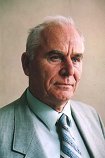Dr. Stepas Janusonis
Dr. Stepas Janusonis is Director of Lithuanian Scientific Society Institute and Head of Self-formation of Artificial Systems group in Lithuania. Being a relatively unknown but promising research area, Self-Formation is a way to increase the performance of products in the field of micro-electronics (semiconductors, including PV cells), nanotechnology, molecular electronics, biotechnology, and other fields. In this way, simpler manufacturing process can be achieved, with associated reduced manufacturing costs. The fundamental principle of Self-Formation is to generate structural growth processes as found in nature by applying smart software based on chaos theory, artificial intelligence and fuzzy logic principles.
The term “self-formation” relates to the process of self-increasing of an object’s complexity. Well-known planar technology for manufacturing of integrated circuits and electron devices based on lithographic processes is not the only possible way to manufacture electronic devices, integrated circuits or photovoltaic cells. Basically, planar technology — which is based on external formation — requires a defined sequence of interactions between a structured medium and the object being formed, in which both the configuration of the region to be formed and its position are defined by the structure of that medium and its alignment with the object. In contrast, self-formation controls the interaction between an object to be formed and a non-structured medium by the object structure itself, and this interaction induces the changes in the object’s structure.
He is editor of the book Self-Formation Theory and Applications: Proceedings of the 6th International Conference on Self-Formation Theory and Applications, held in Vilnius, Lithuania, November 26–28, 2003 (in English) and author or coauthor of A Guide for Amateur Radio Constructors (in Lithuanian), How to transform solar light to electricity (in Lithuanian), Self-formation in Solid-State Technology (in Russian), Microelectronics, V.5. (in Russian) and Lithuanian National Solar Programme 2000–2005, Coordinator of programme performing (in English).
He was the author or coauthor of EU FP5 project FIRST STEP. Self-formation Research Towards Stairway To Excellence in Photovoltaic, Self-formation of the Artificial Planar Systems. What is it? Proceedings of the 6th International Conference in Solid State Phenomena, Self-formation in micro-, nano- and molecular scales- in International Conference on Advances in the Internet, Processing, Systems and Interdisciplinary Research, and EU FP6 project REFLECTS: Novel bifacial single-substrate solar cell utilising reflected solar radiation. Read the complete list of his publications!
He is coinventor of Patent USSR No. 1266397 “Method of manufacturing Shotkey barrier Field-effect transistors”, Patent USSR No. 1176790 “Method of manufacturing of injection logic integrated circuits”, Patent USSR No. 713411 “Method of windows opening in masking layer”, Patent USSR No. 688036 “Method of manufacturing of bipolar transistors”, Patent USSR No. 521802 “Method of selective formation base dopant source for manufacturing of transistor structures”, USA Patent No. 4,069,074 “Method of manufacturing semiconductor devices”, UK Patent No. 1 498 159 “A method of manufacturing semiconductor devices”, France Patent No. 75 35846 “Procede de la fabrication de dispositifs a semi-conducteurs”, Deutche Bundesrepublik Patent No. 2552641 “Verfahren zur Herstellung von Halbleiterbauelementen”, Hungary Patent No. 172486 “Eljaras felvezeto elemek eloallitasara / S.S.Janushonis” (in Hungarian), Czechoslovakia Patent No. 180949 “Zpusob vyroby polovodicoveho prvku” (in Czech), and many other patents.
Stepas graduated as a radio-engineer from Kaunas Polytechnical Institute in 1957, received a Doctor of Engineering (Microelectronics) from Moscow Institute of Micro-Devices in 1966, and received a Dr. Habil. of Engineering (Microelectronics technology) from Moscow Institute of Micro-Devices in 1980.
